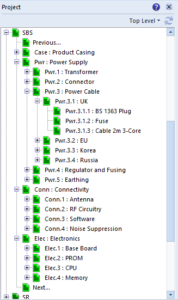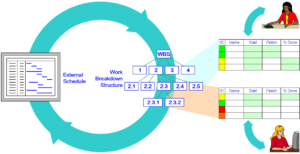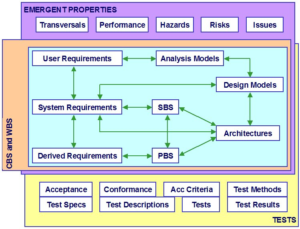Building your Dream
In the words of Phineas T. Barnum starting with the smallest blocks you can build it “….one brick at a time…”
[1] and then you should be able to achieve anything you can dream of.

Consider your ‘dream’ as the top level requirement, this is your ultimate goal. The problem is you’re not sure what constitutes a ‘brick’. Unless it’s a wall you’re building the smallest parts are unlikely to be equal. If only all world engineering problems could be solved with LEGO®! The aim, however is still the same, take the goal and break it down to atomic parts that we can quantify, specify and build. Together those elements will form the whole.
Breakdown Structure
Hierarchies are an important way to describe, link and visualise the ‘dream’ you’re building. The bottom of the hierarchy should be as close to the ‘brick’ as possible. A self contained, unit, the ‘atom’ within your project.
People
Most people are familiar with a company structure from the MD to the process workers via managers and team leaders workers. Imagine a company where every worker tried to talk to the main boss, as soon as there are more than a handful of employees, this would become unmanageable. Conversely consider too many layers of middle management, all pulling in slightly different directions, then the workers end up without clear direction. It’s a balancing act.
Requirement Breakdown
Your ‘dream’ may be to reach for the stars, or it may be to install the machinery to make spaghetti. In both cases you have an end goal, the main top level requirement. In each case these problems can be broken down into smaller problems, launch, travel and land, or ingredients, process and pack.

These in turn may break down into mechanical, electrical and software problems. The decision as to where to break will depend on the industry you are in, the number of issues that need to be tackled and the logical breakdown of the components. In this comparison, the launch may be considered completely different to the travel or landing requirements. However, in the factory system, it may be more prudent to devolve the level directly into the mechanical and electrical areas as there may be no significant difference between process and packing. Falling out the bottom the atomic ‘bricks’ may now be motors, control sensors, and pipes.
Realistically a more complex project can consider in parallel with the ‘dream’ or ‘User Requirements’, that there are the ‘System Requirements‘ which possibly lead to ‘Derived Requirements‘. These in turn link to the ‘System Breakdown Structure‘ (SBS) and ‘Product Breakdown Structure’ (PBS) .
Work Breakdown

When the problem has been broken down into the smallest conceptual parts the order that these must be assembled can also be broken into a hierarchy. The mechanical systems must be installed before they can be wired, the control systems may be developed in parallel, but they can’t be integration tested until the sensors are installed. A work breakdown structure (WBS) is a plan to ensure that the right bricks are in place at the right time to support the next layer of the structure.
Dependencies

There will be a complex relationship between each of the hierarchies in your project. If your team of electrical engineers are required to complete two different parts of the WBS they can’t be completed in parallel. This is where plan schedules are useful. Microsoft® Project is one way to achieve a schedule using Gantt Charts to illustrate the sequencing. The links between which System Requirement links to an item in the SBS or which Derived Requirement links to a PBS item must also be maintained.
Tools
Therefore, to manage a big problem it needs to be broken down into smaller atomic ‘bricks’. But the interrelationship of those components is complex and needs to be managed. Cradle allows all these components to be managed, linked, visualised and reported. From whatever your original concept, to the final brilliant creation, you can build it one brick at a time.
1. Lyrics ‘Barnum’ by Michael Stewart.

